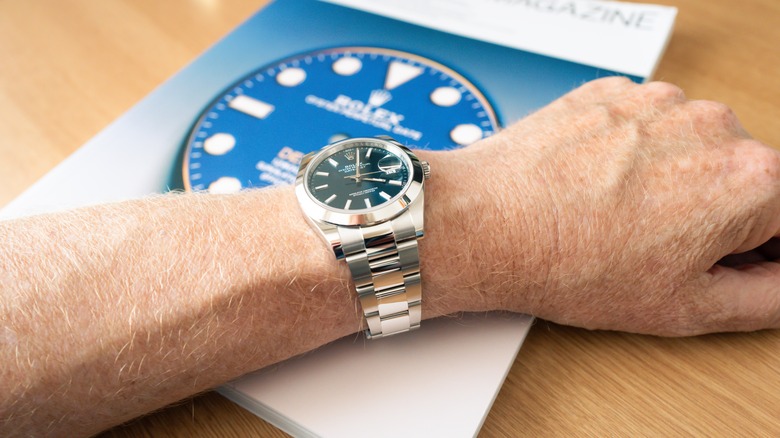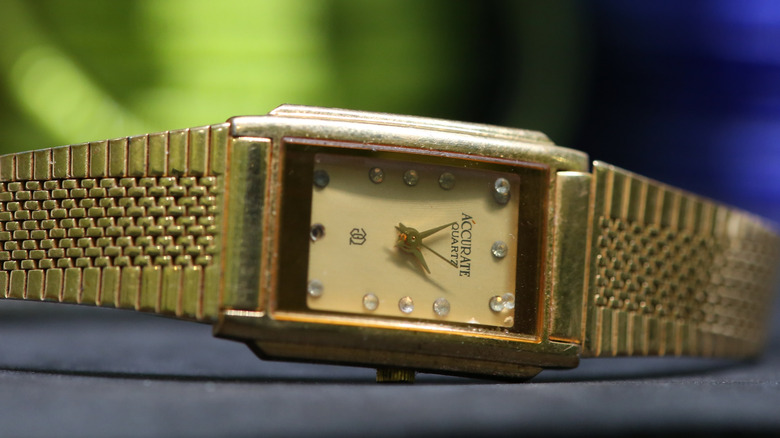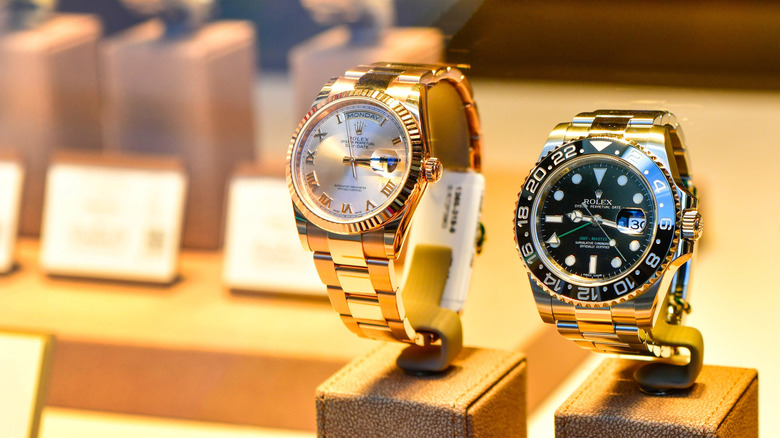10 Myths About Luxury Watches You Need To Stop Believing
The right watch can become the defining piece of any outfit, but you don't even need to shell out millions of dollars for one of the most expensive watches ever sold. Even a stunning luxury watch doesn't have to break the bank. With that being said, there's a ton of misinformation out there concerning luxury watches, and it's important to separate fact from fiction before spending that kind of money.
Some luxury watch myths were once true, but advancing technology has made them moot points. Other myths might make you think you need to spend more money than you actually need to. A superb watch should cost more than what you'll spend on one from Temu, but the industry doesn't live and die by Rolex's standards, either.
Watches are like any other collector's item out there, from purses, to fine art, to clothing. People are willing to spend a lot of money on them, and certain sellers will be more than happy to exploit myths to get consumers to spend even more. Even if a particular myth is pretty harmless, learning what's factual will make you seem like a more informed buyer when the time comes to shell out dough for an exceptional timepiece.
Myth: Rolex is always the best
When most people think of luxury watches, the first name to come to mind is undoubtedly Rolex. And that's not without reason; Rolex crafts excellent timepieces with immaculate designs and precise engineering. The company has been around for over a century, and it's certainly earned its spot within the pantheon of great watches.
However, the conversation surrounding luxury watches shouldn't end with Rolex. There are numerous other brands out there, and depending on who you ask, some might be seen as better than Rolex. When SlashGear ranked every major luxury watch brand, Patek Philippe actually came out on top. That brand also uses the highest-grade materials in its products (and charges a pretty penny), but even if you don't want to spend a fortune, there are plenty of other names that may be more your speed without sacrificing much in the way of quality.
There's rarely an objective "best" of anything — usually there's simply whatever's best for you. A Rolex may not be the best option for your personal style, and you have to be aware that Rolexes are frequently counterfeited, so you should be careful, especially if you're buying from a secondhand source. Besides, Rolex watches can be seen as more of a status symbol than anything else, so if you don't feel the need to brag about how much money you have, another option may be preferable.
Myth: Luxury watches always have to be expensive
Even ignoring luxury watches that go for millions of dollars, some folks may believe they have to shell out an annual salary to get a great item, and indeed some higher-end watches can go for $30,000 or even more. However, there's no reason to spend that much if it's out of your budget. Naturally, these aren't going to be Fossil watches you can get for under $100 a piece, but after some research, you should discover you don't have to pick between a watch or a new car.
There are numerous affordable luxury watch brands out there, including Oris, Bulova, Seiko, and Tissot, to name a few. Seiko has been around since the 19th century, and some its watches sell for only a few hundred dollars. It's a brand name people trust but with options that don't require taking out a bank loan.
You can also save money by looking into the used market. This can involve browsing through local thrift shops or seeing what refurbished models are available from major retailers. Even Walmart sells preowned watches, including Rolexes, that are a fraction of the price of what they would go for used. Plus, you can always lie, so no one ever has to know you bought your fancy new watch from Walmart.
Myth: Swiss made means it all came from Switzerland
To luxury watch aficionados, "Swiss made" is a critical signifier. Switzerland has become synonymous with exceptional watch-making thanks to centuries of honing the craft, so for anyone who wants a timepiece they can proudly show off to the highest rung of society, having it be "Swiss made" is vital. However, that phrase has created a bit of confusion as to how much of a given watch was actually manufactured in Switzerland. You may think it indicates 100%, but that's far from the case.
In order for a company to market a watch as "Swiss made," only about 60% of the work actually needs to have taken place there. Testing and assembly need to occur in Switzerland, while the manufacturer has to make at least half of the components there. A good amount of the work definitely needs to happen in Switzerland, but it's certainly not all.
With that in mind, you may see some watches marketed as being "100% Swiss Made." That means every last detail happened in Switzerland, so knowing the difference can help you decide if a truly Swiss watch is worth the price for you.
Myth: Quartz watches are always better
Those familiar with watch-making history may have heard of the Quartz Crisis. Throughout the 1970s and '80s, quartz watches overtook the industry with the promise of more accurate time-telling and cheaper production. This opened up the market to a new demographic and nearly tanked the entire Swiss watchmaking industry. Of course, Swiss manufacturers were able to rebound, but the myth persists that quartz luxury watches are always preferable to mechanical.
Again, this really comes down to personal preference. Quartz watches utilize batteries to keep track of time while mechanical pieces utilize a mainspring. If you don't regularly wind a mechanical watch, it'll become less accurate and eventually stop working entirely. However, mechanical watches can still be perfectly accurate, which is incredibly impressive considering it's relying on a system of tiny springs, gears, and screws to showcase the time.
Some consumers may prefer the more ornate design of a mechanical watch over a more simplistic quartz option. There's also the personal preference over whether you want your watch to tick every second with a quartz watch or simply make a smooth sweeping motion, which is what you get with mechanical. There's no right answer here, but that means one can't make generalized statements over a certain type being "better."
Myth: You can overwind an automatic watch
Another difference to be aware of when looking at luxury watches is automatic versus mechanical. Automatic watches become wound through the natural movement of your wrist winding up the mainspring whereas mechanical watches require manual winding. Mechanical watches can be overwound, which is why users should stop winding them as soon as they begin to feel resistance from the internal components. Seeing as mechanical watches existed before automatic, the idea of becoming overwound seems to have extended to the automatic variety, even when that's not the case.
There's no real way to overwind an automatic watch by moving your wrist around too often. This is thanks to the inclusion of a rotor mechanism that prevents the mainspring from getting wound up too much through wrist movements. You could flap your arms around all day without worrying of internal damage to the watch.
However, that doesn't mean automatic watches are indestructible. They can still come with a manual winding crank, which turning too much could damage the mainspring, but you shouldn't need to do that as long as you wear it regularly. It's a good idea to wear such a watch often so that it receives the necessary movement to keep track of the time. Lastly, you should keep your automatic watches away from magnets, as they can disrupt the sensitive materials inside.
Myth: Luxury watches don't need maintenance
No matter how much you spend on a watch, you'll still need to service it often. Even the sophisticated Apple Watch requires routine cleaning to work, and luxury watches with all sorts of tiny moving parts do too. Ideally, this won't happen too often, particularly with excessively expensive luxury watches that are designed with the utmost care. Most Rolex watches require maintenance every five to 10 years, but you should be aware of premature signs of degradation so that you can take it into an expert right away.
Hearing a rattling sound inside your watch likely means one of the small components has become loose and needs to be put back in place. You should also be aware of condensation forming underneath the glass plate over the clockface, as moisture could wreak havoc. And if you have a mechanical watch, you should ideally go about 36 to 48 hours between each wind. If you find yourself needing to do that more often, it could be a sign the watch is breaking down.
Luxury watches require lubrication so that all of the components work as they should. Over time, that material will wear out, and you'll need a touch-up so that your watch doesn't break entirely. With routine maintenance, which may only be required once every few years, you can keep your watch viable for decades and help it retain its value long after you purchase it.
Myth: Luxury watches are no longer trendy
With the rise of smartwatches, one may wonder if old-school luxury watches even have a place in the world anymore. The shifting tide has caused some watch manufacturers to change their approach, such as Tag Heuer making expensive smartwatches that may be too pricey for anyone actually to buy. With smartwatches offering so many extra features, it's not hard to envision a world where luxury watches become a thing of the past. Fortunately, based on sales figures over the last couple of decades, it definitely seems like these watches are here to stay.
Sales of luxury watches have only grown since 2003, and it's possible that smartwatches only got people more invested in wearing any kind of watch since they've become more commonplace. One area where luxury watches are really soaring is in the pre-owned market. Vintage items have become trendy accessories, and they're often more affordable than getting a brand new Patek Philippe watch.
And every so often, a watch manufacturer makes headlines for jumping on some contemporary trend, like when Romain Jerome put out a luxury watch adorned with Pokémon characters. As is the case with any industry, luxury watchmakers just need to adapt with the times. However, the rise of smartwatches certainly hasn't diminished luxury watch sales all that much.
Myth: More jewels should always equal a higher price
There's an episode of "The Simpsons" where a teacher showing off how successful he is displays a watch so crammed with jewels it doesn't work properly. In real life, while jewels are certainly pretty, they don't always equate to inherent value.
To be fair, when people talk about jewels in watches, they're usually referring to interior jewels that help reduce friction within the moving components. These tend to be synthetic sapphires and rubies. Ideally, this helps the watch work better, which is more intrinsic in determining its overall value. Since they're usually synthetic anyway, they wouldn't automatically be as valuable as straight-up sapphires and rubies, so it won't always cost as much.
For the most part, watch jewels that aid with movement are largely worthless. Cracking open a watch to try to sell those jewels probably isn't going to net you much of anything, but it can be neat to say how there are rubies inside yours.
Myth: Preowned luxury watches are always a waste of time
While you should definitely conduct a bit more research, preowned luxury watches can be a great option for people just starting out. You can typically get something for far cheaper, and as long as you take care of it, it'll retain its value so you can one day sell it and make back a good amount of money.
Whether you're buying a used luxury watch from a thrift shop, pawn store, or private seller, keep a few things in mind to avoid getting ripped off. There are plenty of counterfeits out there, so ideally, the watch should still have its original box and paperwork confirming its authenticity. You should inspect the movements to ensure everything looks the way it should. If you really want to be certain, you can hire an appraiser to confirm the watch is legitimate before buying.
Looking at preowned luxury watches is a great option, especially if you want to get your first timepiece. You may even feel like trying your hand at restoring a luxury watch and learning about what to look for in a used piece when that's your goal. Plus, buying used opens up a greater variety than what's been most recently released, and you may find something with a certain vintage charm. You still get a high-quality item, and you're doing your part for the environment by giving a watch a second lease on life.
Myth: Luxury watches are exclusively for men
Luxury watches are some of the only accessories men have traditionally worn as a signifier of wealth or status, but, obviously, women can wear luxury watches, too. Many of the top brands now offer more options than ever before primarily targeting women.
Patek Philippe, Cartier, and Bulgari, among others, offer luxury watches with women in mind. Of course, women aren't confined to watches designed for them. Many women have begun opting for timepieces for men, as there tends to be some aesthetic differences that may appeal to some women. Men's watches tend to come with thicker straps and larger clockfaces. They're also more likely to come in darker (i.e. more "masculine") colors. Women may very well want those features for themselves. And as the world has become less bound by gender norms, there's no reason for people to feel confined to a singular box.
Luxury watches are meant for everyone, and with so many options out there, watches exist for people from all walks of life. The most important thing is making sure the watch feels good. No one should place an unnecessary strain on their wrist with a watch that doesn't fit right, no matter how expensive it was.










